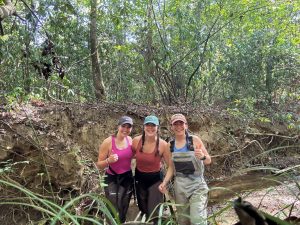
TUSCALOOSA, Ala. – To the south of The University of Alabama’s campus, in the Oakmulgee district of the Talladega National Forest, is the South Sandy Creek watershed. It’s where Dr. Arial Shogren and her students are collecting data to see how ecosystems are impacted by headwater stream networks.
These networks serve as vital arteries that connect terrestrial and aquatic worlds through the flow of water and materials, such as carbon, solutes and sediment. Those materials begin their journey through headwater streams. These small streams make up approximately 80% of all river miles on the planet and serve as sensitive indicators of freshwater vulnerability.
“These systems are extremely susceptible to disturbance from climate change, which is exerting unprecedented pressure on freshwater systems and fundamentally altering how these ecosystems retain and lose essential biogeochemical nutrients like nitrogen and carbon,” said Shogren, UA assistant professor of biological sciences and co-principal investigator on the project.
Shogren’s research is part of the Quantifying Ecosystem exports across Space and Time, or QuEST, project, which is a $2.5 million grant awarded by the U.S. Department of Energy through the Established Program to Stimulate Competitive Research, or EPSCoR.
“With this project, we are integrating empirical data collection and a novel modelling framework to understand how biogeochemical signals propagate downstream as these headwater networks experience changing flow regimes,” she said.
The project is a collaborative effort from early career researchers across institutions spanning six EPSCoR jurisdictions. Led by the University of New Mexico, the other five include: UA, the University of Arkansas, the University of New Hampshire, the University of Nevada, Reno and the University of Oklahoma. They are also partnering with the Watershed Dynamics and Evolution Science Focus Area at Oak Ridge National Lab.
In addition to Alabama’s South Sandy Creek watershed, which drains into the Black Warrior River, the group will study four other headwater watersheds:
- Upper Santa Fe River watershed in New Mexico
- Dog Creek watershed in Nevada
- Richland Creek in Arkansas
- Lamprey River in New Hampshire
Each jurisdiction has unique water resource challenges. In the Western U.S., drought intensity is a foremost concern for drinking water availability, which is an important factor when it comes to making decisions, creating policies and water management. Despite the Southeast being a historically wet region, the team is concerned with how shifts in surface water quantity and quality impact species biodiversity and land management practices.
“Overall, we are hoping that our data-model integration approach will help us understand and predict these impacts,” Shogren said. “We currently lack a predictive understanding of this complex interaction and how it may alter surface water quality, habitat sustainability and drinking water security across the country.”
Shogren and her students help deploy in-situ water quality sensors in the watersheds that can measure water chemistry at high temporal frequencies. One of the sensors her lab will be using for the project is a type of spectrophotometer, which she was able to purchase with the help of the Alabama Water Institute’s equipment support grant.
“The AWI has been extremely supportive of the project, and this spectrolyser will be a ‘bonus’ sensor that I can use to further explore our watershed,” she said.
Since the project is being funded through EPSCoR, not only will the hydrological community benefit from the data collected but so will the scientists through the overall experience.
“The QuEST project is exciting to me from both scientific and personal standpoints as the team is a group of pre-tenured faculty who are also some of my best science friends,” Shogren said. “A major goal of EPSCoR is to enhance the research capabilities of early career researchers, and this project will contribute to strengthening collaboration; training students, postdocs and faculty; and building relationships between our academic institutions and researchers and programs at DOE’s Oak Ridge National Laboratory.
Brock Parker, Multimedia Specialist and Writer, Alabama Water Institute, brockparker@ua.edu
